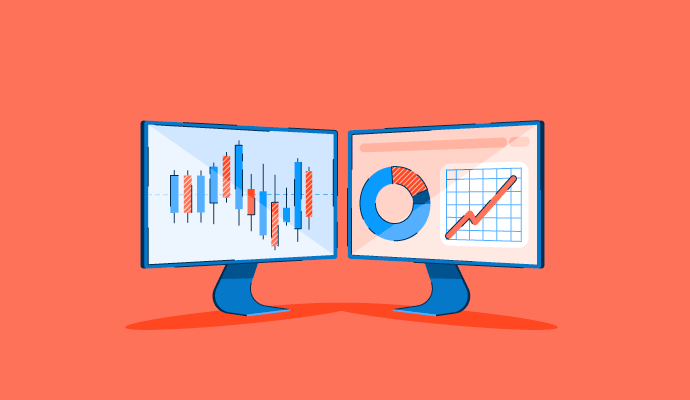

When most people think about turning a profit from a business, they assume it comes from traditional ownership, where you’re the boss and oversee the entire operation.
But that’s not the only way you can make money from a company. In fact, you can own a piece of multiple companies at once, without any of the day-to-day responsibilities of supervision while making some money from their profits. And it’s all thanks to stocks.
Stock, also known as equity, is a type of security that represents a portion of ownership in the corporation that issues the stock. When someone holds stock in a company, that means they own that fraction or percentage of the overall business.
Owning stock means you’re entitled to an equivalent portion of the company’s assets or profits based on how much stock you hold, particularly if you own multiple units of stock, known as shares.
Businesses allow individuals to buy stock in their company in an effort to raise funds that can be used for ongoing operations. People typically buy stock in the hope that theirs increase in value as the company becomes more profitable. The stock can then be sold to another investor for a higher price.
Most investors don’t hold stock in a single company. They invest their money in several companies at once using investment portfolio management software to build, track, and manage their financial assets. Although other types of investment may make up a complete portfolio, stocks and shares usually form the foundation for both new and experienced investors.
While individuals can buy stock in numerous companies, the type of stock that’s on offer is typically broken into one of these two types:
With stocks, the owner has partial ownership of the company proportionate to the shares they hold. This equity can be bought and sold, and grow or shrink in value over time. Companies sell stock to raise capital for funding future growth, with the hope that their overall value and profit will increase over time.
Bonds don’t provide any equity or ownership in a company. Instead, individuals who buy bonds are providing loans that the company pays interest on for a set amount of time. At the end of this period, the total amount that the bond was purchased goes back to the bond owner. These aren’t as risky as stocks, but they do come with their own risks. For instance, if the business goes bankrupt before the bond is repaid, the interest payments stop and the bond owner may not receive their original investment back.
Holding a bond for the lifetime of the loan, known as “holding until maturity” can provide a predictable source of income for the bond owner if the company continues to make payments. As bond payments are seen as a source of income, these funds are taxed differently from other types of investments, usually falling under traditional income tax requirements.
Companies that want to sell stock typically go public through an initial public offering (IPO) whereby investors can make their first stock purchases via a stock exchange, like NASDAQ or the New York Stock Exchange (NYSE).
To purchase stock, investors can go directly to a company or work with a broker or financial advisor. If the buyer already has stock at the company, they can reinvest dividends from existing shares to buy additional stock.
The value of stock fluctuates based on supply and demand, along with wider economic market conditions and other factors. If a business turns a profit, stock value increases and catches a higher rate than their original price point. If the company loses value or goes out of business completely, stock value plummets and investors may lose some or all of their initial investment. Most investors have a diversified portfolio to lower the risks that come with this type of investment.
Since it’s possible to make or lose a significant amount of money through buying and selling stock, this trade is subject to strict government regulations to protect investors from fraud.
If you want to start buying stocks, you have to have a reliable way to track and manage your investments, especially if you’re working with multiple companies. Using investment portfolio management software benefits individuals and professionals because it offers a holistic view of all related activities.
To be included in the investment portfolio management software category, platforms must:
* Below are the top five leading investment portfolio management software solutions from G2’s Spring 2024 Grid Report. Some reviews may be edited for clarity.
Morningstar Direct helps investors research markets, position products, analyze competition, and share insights. With portfolio analysis and construction features, new investors can start from scratch, while Morningstar’s ongoing due diligence and asset allocation makes managing investments simple.
“Morningstar Direct is a powerhouse when it comes to data. It's got a ton of features and access to a crazy amount of information on all sorts of investments like mutual funds, stocks, and ETFs. If you're in the investment industry, this platform can be a real lifesaver.”
- Morningstar Direct Review, James M.
“There can be considerable lag at times when working through Presentation Studio. They have suggested it is a connection issue, as their version runs quickly in house, but I have found it to run slower. You are at their whim regarding features; we use a couple reports consistently, and their support has slowly been waning.”
- Morningstar Direct Review, Ross S.
Pershing Financial Services offers financial services professionals and investment brokers a fully customizable client relationship management software tool. Using Pershing gives you market analysis in real time, investment accounting support, reporting, data aggregation, and risk management analysis. With a client portal built in, the software makes it easy to track and manage multiple investments.
“Pershing's user interface (UI) is easy to adjust to your needs, which is one of my favorite features. It allows you to keep track of all client activity, holdings, client profiles, and scanned documents on a single interface.”
- Pershing Financial Services Review, Animesh S.
“I have used the mobile app of Pershing Financial Services and it’s not up to date with the web app. The UI is not perfectly user-friendly, so they should work on the mobile app usability.”
- Pershing Financial Services Review, Vishal B.
As a financial growth management platform for wealth management companies, Nitrogen empowers fearless investment. With multi-factor analysis and risk management features, the software keeps investment managers on track with current trading conditions at any time, from anywhere.
“I love that I can easily walk a client through the current risk of their portfolio and the recommended changes. The stress-test feature is also very useful. The best aspect for me is the rebalancing. It is easy to use their models, create your own, and trade on your preferred platform. It saves valuable time.”
- Nitrogen Review, Maggie K.
“The main drawback has to be with structured note limitations in not recognizing characters and descriptions. This has also been a problem for some annuity products.”
- Nitrogen Review, Thomas M.
Altruist provides advisors with cutting-edge tools to open accounts and manage bill clients from a single piece of software. Portfolios are fully customizable, making it easier for investment managers to work proactively for clients and make investments that best fit their needs.
“Altruist is an excellent solution for registered investment advisors looking to streamline their wealth management. With automated solutions for customized portfolio building, performance reporting, and fee billing, it's an essential tool for the modern advisor.”
- Altruist Review, TJ V.
“Because Altruist is so new, they don't have some things that more established platforms have, such as margin and certain account types.”
- Altruist Review, Cole F.
Simply Wall St offers a new, easy-to-understand way for investing in the stock market. With visual formatting and data representation, the software makes it easy for both new and experienced investors to see graphs of current stock data and make informed decisions about what to buy or sell.
“Snowflake analysis is the best thing I liked in the app, as well as the detailed analysis and comparison with other companies of the industry. Overall, the app is very user friendly and the UI is also very good.”
- Simply Wall St Review, Sandeep K.
“Generating reports can be a bit tricky sometimes so you have to be very careful with that.”
- Simply Wall St Review, Surabhi B.
Investing can feel confusing, but when you’re teamed up with a trustworthy financial professional, you’ll make better decisions about what to do with your money. Stocks might be risky, but they can also come with plenty of reward. With such a range of software platforms, now is the best time to give it a try.
Find investment firms to guide you and your business with your monetary investments.

Diversify your portfolio with stocks using investment portfolio management software that does the work for you.
Holly Landis is a freelance writer for G2. She also specializes in being a digital marketing consultant, focusing in on-page SEO, copy, and content writing. She works with SMEs and creative businesses that want to be more intentional with their digital strategies and grow organically on channels they own. As a Brit now living in the USA, you'll usually find her drinking copious amounts of tea in her cherished Anne Boleyn mug while watching endless reruns of Parks and Rec.

Diversify your portfolio with stocks using investment portfolio management software that does the work for you.
“Give me my check...or pay me in equity,” sang Beyoncé on a single off her joint album with...
 by Maddie Rehayem
by Maddie Rehayem
Investing is a game of risk, and in 2019 there are new ways to play.
 by Maddie Rehayem
by Maddie Rehayem
If you could have any superpower, what would it be?
 by Maddie Rehayem
by Maddie Rehayem
“Give me my check...or pay me in equity,” sang Beyoncé on a single off her joint album with...
 by Maddie Rehayem
by Maddie Rehayem
Investing is a game of risk, and in 2019 there are new ways to play.
 by Maddie Rehayem
by Maddie Rehayem
Never miss a post.
Subscribe to keep your fingers on the tech pulse.



